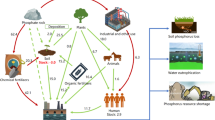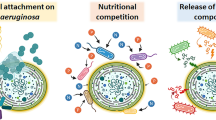Abstract
The objective of this work was to understand and optimize the flocculation of a marine alga Nannochloropsis oculata with two cationic salts, aluminum sulfate (AS), and ferric chloride (FC). Based on single-factor and response-surface-methodology experiments, second-order polynomial models were developed to examine the effect of initial algal biomass concentration (IABC), pH, and flocculant dose (FD) on final solid concentration of algae (SCA). The experimental and modeling results showed that SCA favored low pH, which however was undesirable to biomass recovery rate. There existed a positive stoichiometric relationship between FD and IABC; higher IABC required higher FD, and vice versa, for higher SCA. Optimum flocculation conditions were predicted at IABC of 1.7 g/l, pH 8.3, and FD of 383.5 μM for AS, and IABC of 2.2 g/l, pH 7.9, and FD of 438.1 μM for FC, under which the predicted maximum SCA were 32.98 and 30.10 g/l using AS and FC, respectively. The predictions were close to validation experimental results, indicating that the models can be used to guide and optimize the flocculation of N. oculata using AS and FC as the flocculants.






Similar content being viewed by others
References
Garcia, J., Mujeriego, R., & Hernandez-Marine, M. (2000). High rate algal pond operating strategies for urban wastewater nitrogen removal. Journal of Applied Phycology, 12, 331–339.
Chisti, Y. (2007). Biodiesel from microalgae. Biotechnolgoy Advances, 25(2), 294–306.
Mark, E. H., & Donald, G. R. (2007). CO2 mitigation and renewable oil from photosynthetic microbes: A new appraisal. Mitigation and Adaptation Strategies for Global Change, 12, 573–608.
Shen, Y., Yuan, W., Pei, Z., & Mao, E. (2008). Culture of microalga Botryococcus in livestock wastewater. Transaction of the ASABE, 54(4), 1395–1400.
Grima, E. M. M., Belarbi, E. H., Fernandez, F. G. A., Medina, A. R., & Chisti, Y. (2003). Recovery of microalgal biomass and metabolites: Process options and economics. Biotechnology Advances, 20, 491–515.
Hu, Q., and Sommerfeld, M. (2008). Photobioreactor: System and process. Presentation at Algae Biomass Summit, Seattle, WA, USA.
Carlsson, A.S., Beilen, J.B., Moller, R., and Clayton, D. (2007). Micro- and macro-algae: utility for industrial applications. Outputs from the EPOBIO project.
Green, F.B. (2008). Harvesting microalgae: Challenges and achievements. Presented at Algae Biomass Summit.
Kim, T. J. K., Oh, J., Ryou, D. C., Moon, B. Y., Kim, Y. J., & Kim, S. H. (2009). Full-scale demonstration of improvement of sludge treatment performance. Desalination and Water Treatment, 2, 65–69.
Massingill, M.J., Carlberg, J.M., Schwartz, G., Van Olst, J.C., Levin, J.C., and Brune, D.E. (2008). Sustainable large-scale microalgae cultivation for the economical production of biofuels and other valuable by-products. Presented at Algae Biomass Summit.
Mohn, F. H. (1980). Experiences and strategies in the recovery of biomass from mass cultures of microalgae. In G. Shelf & C. J. Soeder (Eds.), Algae biomass (pp. 547–571). Amsterdam: Elsevier.
Rossignol, N., Lebeau, T., Jaouen, P., & Robert, J. M. (2000). Comparison of two membrane-photobioreactors, with free or immobilized cells, for the production of pigments by a marine diatom. Bioprocess Engineering, 23, 495–501.
Brune, D.E., Lundquist, T., and Benemann, J. (2008). Algal production and harvest for food, feed and biofuels. Presented at Algal Biomass Summit.
Divakaran, R., & Pillai, V. N. S. (2002). Flocculation of algae using chitosan. Journal of Applied Physics, 14, 419–422.
Lee, S. J., Kim, S. B., Kim, J. E., Kwon, G. S., Yoon, B. D., & Oh, H. M. (1998). Effects of harvesting method and growth stage on the flocculation of green alga Botryococcus braunii. Letters in Applied Microbiology, 27, 14–18.
Papazi, A., Makridis, P., & Divanach, P. (2009). Harvesting Chlorella minutissima using cell coagulants. Journal of Applied Phycology, 9(03), 1573–1576.
Valdes, F.J., Hernandez, M.D.R, Gomez, A., Marcilla, A., and Chapuli, E. (2008). Study of the efficiency of different flocculants for effective microalgae harvesting. http://rua.ua.es/dspace/bitstream/10045/8536/1/Poster%20expoquimia%20floculacion%20(2008).pdf.
Knuckey, R. M., Brown, M. R., Robert, R., & Framton, D. M. F. (2006). Production of microalgal concentrates by flocculation and their assessment as aquaculture feeds. Aquacultural Engineering, 35(3), 300–313.
Sirin, S., Trobajo, R., Ibanez, C., & Salvadó, J. (2011). Harvesting the microalgae Phaeodactylum tricornutum with polyaluminum chloride, aluminium sulphate, chitosan and alkalinity-induced flocculation. Journal of Applied Phycology, 4(11), 1067–1080.
Yan, Z. (2012). Biomass and flocculation characteristics of Picochlorum oklahomensis and Nannochloropsis oculate. Master thesis, Oklahoma State University.
Gieskes, T. E. (2008). Algae oil extraction. Organic fuels presentation. http://www.organicfuels.com/library/art/Organic%20Fuels%20Presentation%20NAA%202008%2004%2010.pdf.
Sanyano, N., Chetpattananondh, P., Chongkhong, S. (2011). Optimization of flocculation of marine Chlorella sp. by response surface methodology. TICHE International Conference at Hatyai, Songkhla, Thailand.
Shen, Y., Ty, M., Pei, Z., and Yuan, W. (2009). The effect of growth medium on biomass and lipid yield of microalgae Nanochloropsis. Mid-Central Conference of A.S.ABE.
Sukenik, A., & Shelet, G. (1984). Algal autoflocculation–verification and proposed mechanism. Biotechnology and Bioengineering, 26(2), 142–147.
Wyatt, N. B., Gloe, L. M., Brady, P. V., Hewson, J. C., Grillet, A. M., Hankins, M. G., et al. (2012). Critical conditions for ferric chloride-induced flocculation of freshwater algae. Biotechnology and Bioengineering, 109(2), 493–501.
Bare, W. F. R., Jones, N. B., & Middlebrooks, E. J. (1975). Algae removal using dissolved air flotation. Journal of the Water Pollution Control Federation, 47, 153–169.
Friedman, A. A., Peaks, D. A., & Nichols, R. L. (1977). Algae separation from oxidation pond effluents. Journal of the Water Pollution Control Federation, 49, 111–119.
Moraine, R., Shelef, G., Sandbank, E., Bar Moshe, Z., and Schwarbard, L. (1980). Recovery of sewage born algae: Flocculation and centrifugation techniques. In G. shelef and C. J. Solder (Eds.), Algae biomass. Amsterdam: Elsevier/North Holland.
Zhu, C. J., & Lee, Y. K. (1997). Determination of biomass dry weight of marine microalgae. Journal of Applied Phycology, 9, 189–194.
Zhang, H., Kuang, Y., Zhe, L., & Liu, C. (2011). Influence on surface characteristics of microalgae cell by solution chemistry. Advanced Materials Research, 287–290, 1938–1942.
Ayoub, G. M., Lee, S. I., & Koopman, B. (1986). Seawater induced algal flocculation. Water Research, 20(10), 1265–1271.
Ives, K. J. (1959). The significance of surface electric charge on algae in water purification. Journal of Biochemical and Microbiological Technology and Engineering, 1(1), 37–47.
Gregory, J., & Duan, J. (2001). Hydrolyzing metal salts as coagulants. Pure and Applied Chemistry, 73(12), 2017–2026.
Hansjoachim, S. and Dobias, B. (2005). Coagulation and flocculation (pp. 384–407). Boca Raton: CRC
Harith, Z. T., Yusoff, F. M., Mohamed, M. S., Din, M. S. M., & Ariff, A. B. (2009). Effect of different flocculants on the flocculation performance of microalgae, chaetoceros calcitrans, cells. African Journal of Biotechnology, 8(21), 5971–5978.
Acknowledgments
The authors thank Dr. Yuhong Zeng in the Macromolecule and Vaccine Stabilization Center of University of Kansas for assistance in zeta potential measurement. This research was financially supported by the US National Science Foundation (award number CMMI-1239078). Part of this work was also funded by the Natural Science Foundation of China (award number 51108085), “863” Project (award number 2012AA021704), the Natural Science Foundation of Fujian Province (award number 2011J05125), and the start-up fund of North Carolina State University.
Author information
Authors and Affiliations
Corresponding author
Rights and permissions
About this article
Cite this article
Shen, Y., Cui, Y. & Yuan, W. Flocculation Optimization of Microalga Nannochloropsis oculata . Appl Biochem Biotechnol 169, 2049–2063 (2013). https://doi.org/10.1007/s12010-013-0123-4
Received:
Accepted:
Published:
Issue Date:
DOI: https://doi.org/10.1007/s12010-013-0123-4




